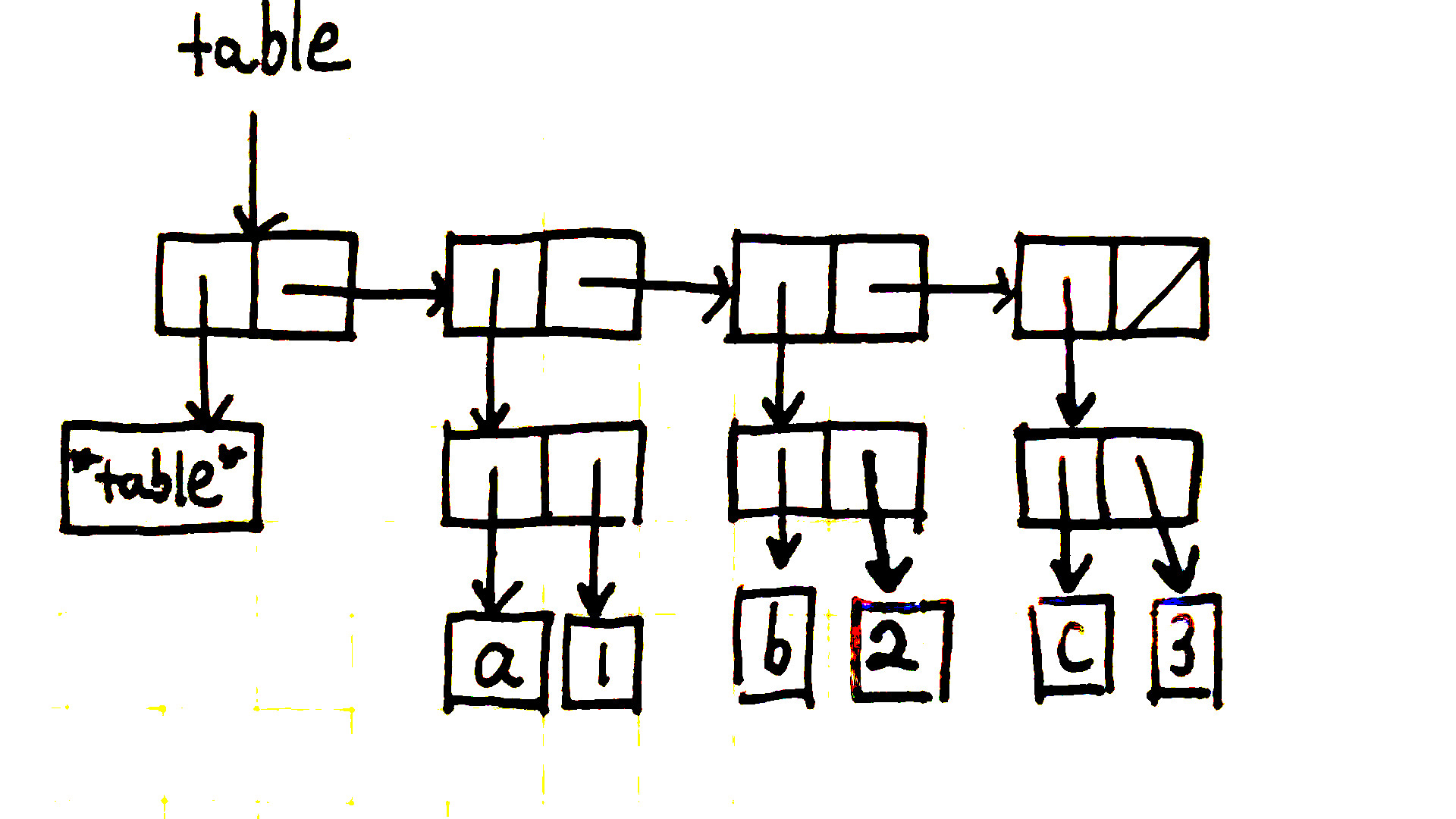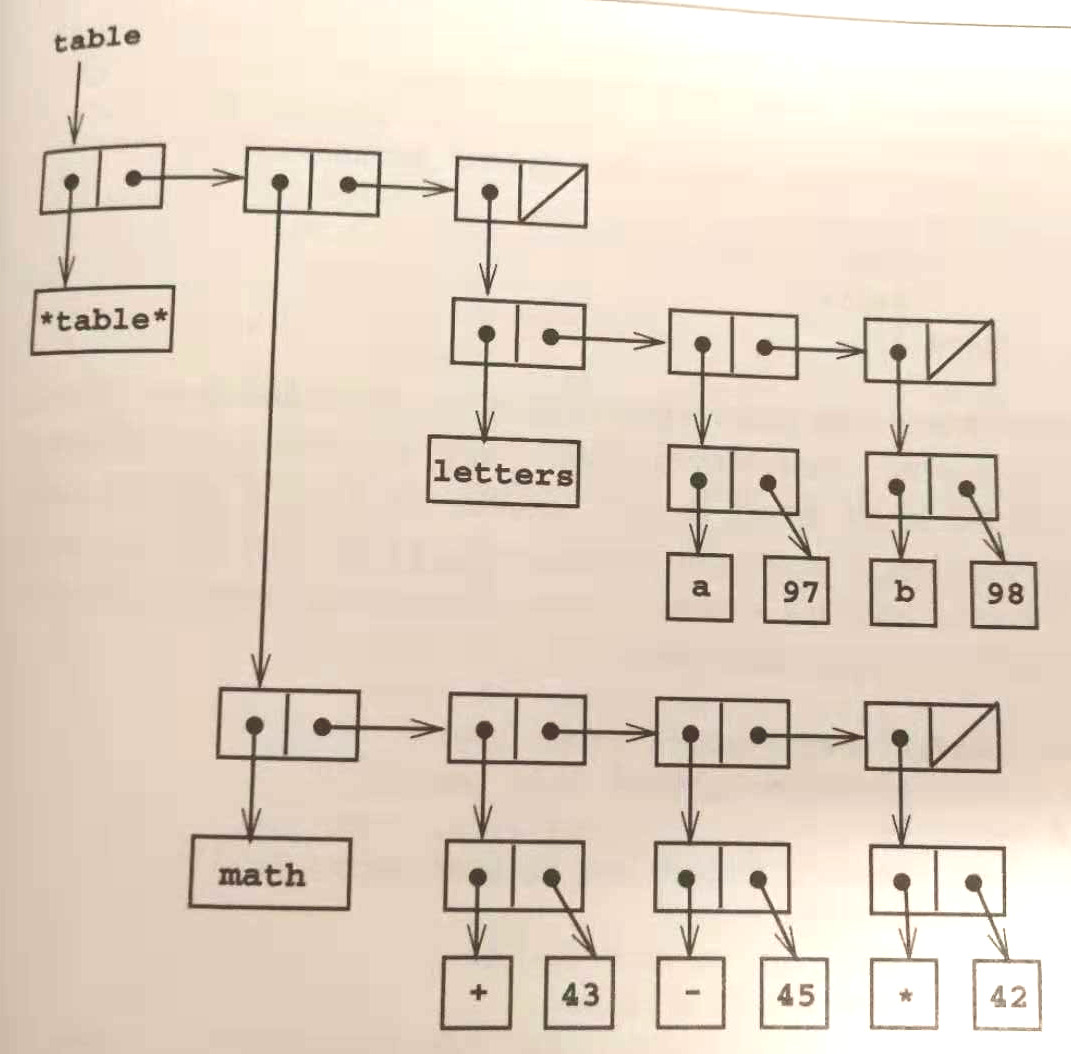SICP Goodness - Mutable Data (II)
Modeling with mutable data

Do you think Computer Science equals building websites and mobile apps?
Are you feeling that you are doing repetitive and not so intelligent work?
Are you feeling a bit sick about reading manuals and copy-pasting code and keep poking around until it works all day long?
Do you want to understand the soul of Computer Science?
If yes, read SICP!!!
Representing Tables
We can build a table data structure by just using pairs.
For example, the box-and-pointer diagram of the folllowing table would be:
a: 1
b: 2
c: 3
The head of the table list is a meaningless pair with symbol table as car. This is used for a fixed place to insert new key/value pair as we will see later.
Lookup
Procedure lookup looks up value by key from the table.
(define (lookup key table)
(let ((record (assoc key (cdr table))))
(if record
(cdr record)
false)))
(define (assoc key records)
(cond ((null? records) false)
((equal? key (caar records)) (car records))
(else (assoc key (cdr records)))))Insert
To insert a value in the table under a specific key. First check if the table contains such key, if yes, we set the new value under it. If not, we create a new record and put it as the first item the table list after the table head.
(define (insert! key value table)
(let ((record (assoc key (cdr table))))
(if record
(set-cdr! record value)
(set-cdr! table (cons (cons key value) (cdr table))))))Create a Table
This is easy, just create a list containing only item *table*.
(define (make-table)
(list '*table*))Two dimentional Table
In a two-dimentional table, each value is indexed by two keys.
For example:
math:
+: 43
-: 45
*: 42
letters:
a: 97
b: 98The box-and-pointer diagram of it would be:

Lookup
Lookup is similar to the one-dimentional table, just do a nested assoc instead.
(define (look-up key-1 key-2 table)
(let ((subtable (assoc key-1 (cdr table))))
(if subtable
(let ((record (assoc key-2 (cdr subtable))))
(if record
(cdr record)
false))
false)))Insert
This is also not hard, just need to be a bit careful.
(define (insert! key-1 key-2 value table)
(let ((subtable (assoc key-1 (cdr table))))
(if subtable
(let ((record (assoc key-2 (cdr subtable))))
(if record
(set-cdr! record value)
(set-cdr! subtable
(cons (cons key-2 value)
(cdr subtable)))))
(set-cdr! table
(cons (list key-1 (cons key-2 value))
(cdr table)))))
'ok)Creating local tables
Up until now, we are kind of working like C style, writing functions that operate on table data structures.
We can actually work more like OO style very easily by representing table as an object, and send messages to it.
(define (make-table)
(let ((local-table (list '*table*)))
(define (lookup key-1 key-2)
(let ((subtable
(assoc key-1 (cdr local-table))))
(if subtable
(let ((record
(assoc key-2
(cdr subtable))))
(if record (cdr record) false))
false)))
(define (insert! key-1 key-2 value)
(let ((subtable
(assoc key-1 (cdr local-table))))
(if subtable
(let ((record
(assoc key-2
(cdr subtable))))
(if record
(set-cdr! record value)
(set-cdr!
subtable
(cons (cons key-2 value)
(cdr subtable)))))
(set-cdr!
local-table
(cons (list key-1
(cons key-2 value))
(cdr local-table)))))
'ok)
(define (dispatch m)
(cond ((eq? m 'lookup-proc) lookup)
((eq? m 'insert-proc!) insert!)
(else (error "Unknown operation:
TABLE" m))))
dispatch))By doing this, we can do things like:
(define operation-table (make-table))
(define get (operation-table 'lookup-proc))
(define put (operation-table 'insert-proc!))P.S. Now with the knowledge of tables, we can introduce the data directed programming next. Stay tuned!

Share this post
Twitter
Google+
Facebook
Reddit
LinkedIn
StumbleUpon
Email